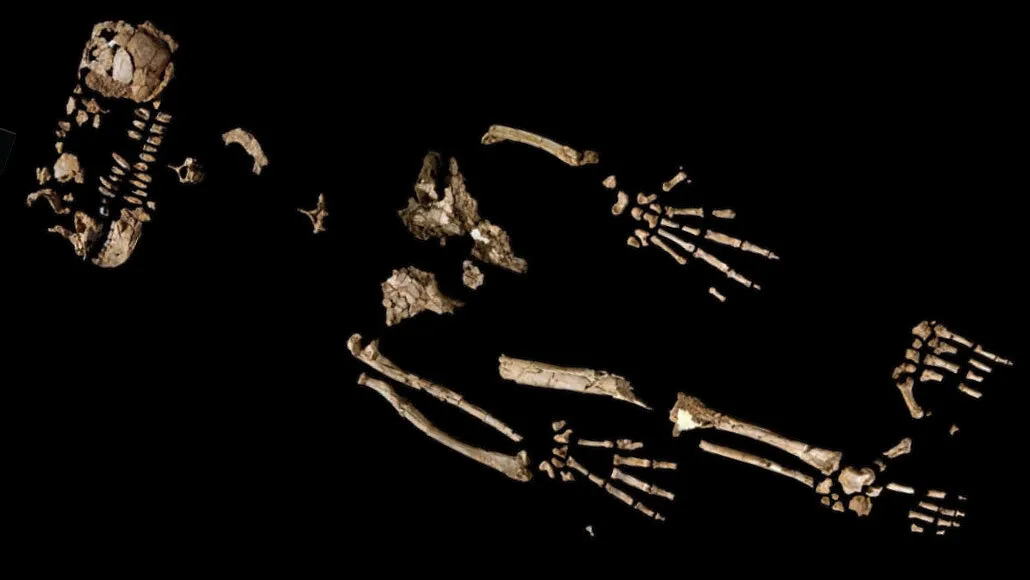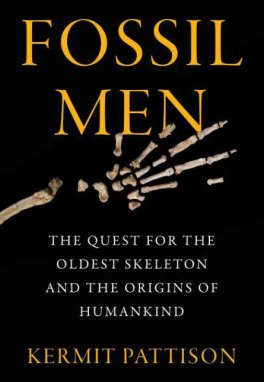Ardi and her discoverers shake up hominid evolution in ‘Fossil Men’
A new book blends science and drama to tell the story of a major paleoanthropology find

The story of the discovery of Ardi, the hominid skeleton shown in this composite image, involves a colorful cast of characters and plenty of drama.
T.D. White et al/Science 2009

Fossil Men
Kermit Pattison
William Morrow, $32.50
She is the most controversial, convention-defying, weirdest-looking fossil hominid ever found. Fittingly, the group that discovered this 4.4-million-year-old adult female, nicknamed Ardi, includes the most controversial, convention-defying (and some would say weirdest-acting) fossil hunters and bone analysts to have ever wrestled with the puzzle of how humans and our ancestors evolved.
In Fossil Men, journalist Kermit Pattison recounts intriguing backstories of the Ardi scientists and how they came to challenge popular views of hominid evolution. Many incidents in the book show the courage and grit it took to find and excavate Ardi in Ethiopia’s remote Middle Awash area, where local nomadic groups are prone to shoot at outsiders. Pattison also examines how Ardi’s skeleton makes her a one-of-a-kind find.
Standing at the center of this ancestral spectacle is team leader Tim White, a paleoanthropologist at the University of California, Berkeley. A demanding and intense taskmaster in the field, White has a hard-earned reputation as one of the all-time great fossil hunters. Pattison describes White as having remarkably keen eyes for assessing fossil bones and a knack for brutal, sarcastic takedowns of evolutionary arguments (and scientists) he finds deficient. In a published review of an eminent anthropologist’s book claiming that hominid evolution included many species, White called him a purveyor of “politically correct paleoanthropological pontification” that didn’t rise to the level of fiction such as The Clan of the Cave Bear. Not surprisingly, White has amassed scientific enemies since the early 1970s, when he worked with members of the fossil-hunting Leakey family in Africa. He takes his professional infamy in stride.
After helping to study and classify the famous Lucy partial skeleton following its discovery in 1974, White’s friendship with Lucy’s discoverer Donald Johanson broke up, much as his relationship with the Leakeys had. White then took a position at Berkeley in 1977, where he joined forces with archaeologist J. Desmond Clark to hunt for hominid fossils in the Middle Awash. There, remains older than 3.2-million-year-old Lucy were likely waiting. Clark recruited Ethiopia’s Berhane Asfaw to Berkeley’s graduate anthropology program, the first of a series of Ethiopians the Ardi team trained as paleoanthropologists. Asfaw joined the White-led fossil expeditions and had headed an Ethiopian museum that now houses Ardi.
Sign up for our newsletter
We summarize the week's scientific breakthroughs every Thursday.
Pattison recounts a pivotal moment in the field when the team encountered a man named Gadi, a hunchbacked, gun-wielding warrior from a local tribe called the Afar. White struck up a friendship with Gadi, who became a one-man security force for the researchers. In 1993, it was Gadi who noticed a tooth on the ground that was the first of 10 teeth the team found from the same hominid individual. These clues led to the identification of a new species, Ardipithecus ramidus.
The first pieces of Ardi’s partial skeleton — including much of the skull, hands, limbs and pelvis — were found the following year, about 100 kilometers south of where Lucy had been unearthed. Pattison uses anecdotes from the field, gleaned from interviews and White’s trove of videos and photos from years of fieldwork, to describe the dangers and rigors of the three years it took to excavate Ardi’s remains. Pattison also illuminates how an insistence by White’s team on painstaking preservation of the fragile fossils and exhaustive comparisons to other species to reconstruct Ardi’s body plan over the next 15 years clashed with many paleoanthropologists’ desire to get quick access to Ardi for their own studies.
The literary flow slows as Pattison probes the ins and outs of Ardi’s skeletal parts. But patient readers are rewarded with a vision of a somewhat apelike, somewhat monkeylike, somewhat humanlike creature (SN: 1/16/10, p. 22) that, its discoverers argue, destroys the influential view that early hominids looked much like chimpanzees after having evolved from a knuckle-walking ancestor.
For anyone interested in fossil hunting, evolutionary science and a hominid skeleton like no other, this book delivers.
Buy Fossil Men from Amazon.com. Science News is a participant in the Amazon Services LLC Associates Program. Please see our FAQ for more details.







